Tieguanyin Tea
(Iron Goddess of Mercy)
An Insider's Guide
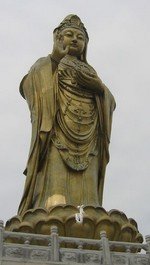 While there are
hundreds
of different types of oolong tea, one tea stands out head and shoulder above the
rest. Even the Guinness Book of Records takes notice. The Tieguanyin tea is the reigning holder of the
priciest tea.
While there are
hundreds
of different types of oolong tea, one tea stands out head and shoulder above the
rest. Even the Guinness Book of Records takes notice. The Tieguanyin tea is the reigning holder of the
priciest tea.
She is the most famous tea plant in human history, now lending its name to the entire family of ball-shaped oolong tea cultivated in China and Taiwan.
The tea plant was originally discovered in the Xiping village of Anxi County in the 18th century.
Tie means iron. Guanyin is the Goddess of Mercy, the Chinese equivalent of Buddhist deity Avalokitesvara (Tibetan name Chenrezig), the Lord of compassion and love.
It has many spellings. Besides Tieguanyin, it is also known as Ti Kuan Yin, Tit Kwun Yum, Ti Kwan Yin, Tie Guan Yin, Iron Buddha and Iron Goddess of Mercy.
Anxi Tieguanyin tea belongs to a family of teas from southern Fujian Province called Ming Nan Oolong.
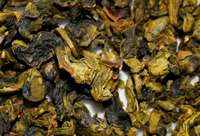 It is characterized by light oxidation and
heavy rolling. Using the baorou technique, it is
wrapped in cloths and rolled into tightly knitted balls.
It is characterized by light oxidation and
heavy rolling. Using the baorou technique, it is
wrapped in cloths and rolled into tightly knitted balls.
These balls are so dense that they are often described as iron-like. It has a glossy appearance, with granulated green color, red spots and white frost.
It has a unique taste called Guanyin Rhyme (Yin Yun), which can be described as outstanding orchid fragrance and nectar sweet taste.
A Chinese study offers an insight into why it is so special.
Scientists found that the Tieguanyin tea plant's succulent leaves contain the highest level of aromatic substances, especially at low to medium temperature.
For those who have difficulty grasping the subtleties of high grade greens, this oolong tea may seem "god-sent". Its orchid aroma is strong, lasting and after many infusions, simply intoxicating.
If you were to visit Xiping, you would come across two sites that are linked to the origin of this tea. There is a story behind each of them.
Wei Shuo
Wei was a sincere Buddhist and prayed to the Goddess of Mercy daily. One night, he dreamed of a magic plant, which he discovered the next day.
Having recognised the plant to be the same as his dream, he brought it back home for cultivation. It was found to be very fragrant and dense as an iron.
Suspecting that it was a gift from the Goddess of Mercy, he decided to call it Tieguanyin tea.
Wang Shuo
Wang was a scholar who accidentally discovered the tea plant beneath the Guanyin rock in Xiping. He brought the plant back home for cultivation.
When he visited Emperor Qianlong in the 6th year of his reign, he offered the tea as a gift from his native village. Emperor Qianlong was so impressed that he inquired about its origin.
Since the tea was discovered beneath the Guanyin Rock, he decided to called it the Guanyin tea.
Like the Wuyi Mountain, Anxi County is renowned for its biodiversity of tea plants.
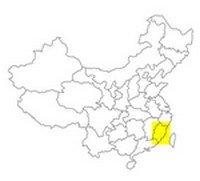 It boasts more than 60
superior varieties, of which the famous ones include Tieguanyin, Huangdan, Benshan, Maoxie, Daye
Wulong and Meizhan.
It boasts more than 60
superior varieties, of which the famous ones include Tieguanyin, Huangdan, Benshan, Maoxie, Daye
Wulong and Meizhan.
Anxi County can be divided into Inner and Outer Anxi.
Inner Anxi has high altitude and is endowed with moderate climate, humid conditions, abundant rainfalls, thick earth and rich soils - the kind of conditions that make great teas.
The entire region is devoted to producing tea. There is little or no pollution.
Outer Anxi has lower altitude. It is nearer to the cities and is more polluted. Tea quality is lower.
A standard pick is one bud with 2 or 3 leaves, when the buds at the top of a bush reach one-third to half the size of a mature leaf.
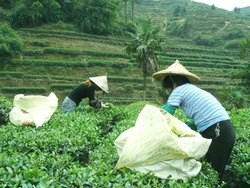 Harvesting can take place 4 times a year:
Harvesting can take place 4 times a year:
- Spring tea (Chun Cha or Jade) from
mid April to mid May
- Mid summer tea (Xia Cha) from mid
June to mid July
- Late summer tea (Shu Cha) in
August
- Autumn tea (Qiu Cha) from mid September to mid October
Which season yields the best tea?
According to my tea garden in Xiping, spring tea is the tastiest, but autumn tea is more fragrant.
Summer tea is the lowest quality. Buyers beware. Unscrupulous vendors frequently sell late summer as autumn tea.
Tea garden produces less tea as the year progresses.
Spring tea is the most abundant and makes up 45% to 50% of annual production. Autumn tea is the rarest and makes up 10% to 15% of annual production.
The difference in supply may partly explain why autumn tea may cost more than spring tea.
Withering (Weidiao)
Freshly picked leaves are left to cool indoors first, then moved outdoors to sun dry, before moving indoors again for final withering.
Late afternoon sun at around 4 p.m. is thought to be the best for sun drying.
Bruising (Zhuoqing or Yaoqing)
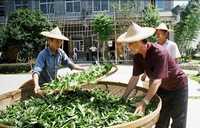 Shake and rub using hands or machines to
bruise leaf edges.
Shake and rub using hands or machines to
bruise leaf edges.
This exposes tea juices to air and facilitates the oxidation process.
Tieguanyin has fat leaves, so bruising is heavier and longer. It is repeated 5 to 6 times, and left to oxidise in between.
Roasting (Chaoqing)
Pan-fry leaves at high heat for short period of time to kill tea enzymes and stop the oxidation process.
It is carried out just after the grassy smell has dissipated, when the aroma substances are starting to form.
Rolling (Rounian)-Baking (Hongbei)
Roll leaves into balls. Then apply heat to dry it further. This rolling-drying combination is repeated 3 times.
After that, apply low heat to increase mellow taste until the tea acquires a glossy appearance and a white surface frost.
Sorting
Remove sub standard leaves and twigs.
Tieguanyin tea can mean different things to different people.
In Japan, it is so popular that it is synonymous with oolong tea.
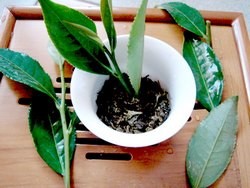 When used broadly, Tieguanyin tea refers to
the entire family of teas produced in southern Fujian, which include quality
varieties such as
When used broadly, Tieguanyin tea refers to
the entire family of teas produced in southern Fujian, which include quality
varieties such as
- Huang Jin Gui (Golden Cassia)
- Ben Shan (Ben Mountain)
- Da Ye Wu Long (Big Leaf Wu Long)
- Mao Xie (Hairy Crab)
- Mei Zhan (Plum Coin)
- Qi Lan (Rare Orchid)
- Fo Shou (Buddha Hands)
All these teas use the tieguanyin process to produce ball shaped oolong tea.
In Taiwan, Tieguanyin tea includes the entire family of ball-shaped oolong tea. They do not necessarily grow from the Tieguanyin plant, but use the Tieguanyin process.
- Mu Zha (Wooden Gate)
- Shi Men (Stone Door)
The Mu Zha variety is the most highly regarded.
Interestingly, it is a direct descendant of the Tieguanyin plant. A man called Zhang Nai Mai transported it from Anxi to Taiwan for cultivation in the 20th century.
When used narrowly, tieguanyin refers to teas picked from Tieguanyin plant. Villages such as Xiping, Xianghua and Gande in Inner Anxi County produce the best Tieguanyin tea.
New! Comments: Like This Story? Leave A Comment!
References
Chen Zhong Xian (1992). Zhongguo Chajing. Shanghai Wenhua Chubanshe.
Back to Top of Tieguanyin Tea
Back to Iron Goddess Tea Main Page
Back to Tea Shop Main Page
- Home
- Shop
- Iron Goddess
- Here
